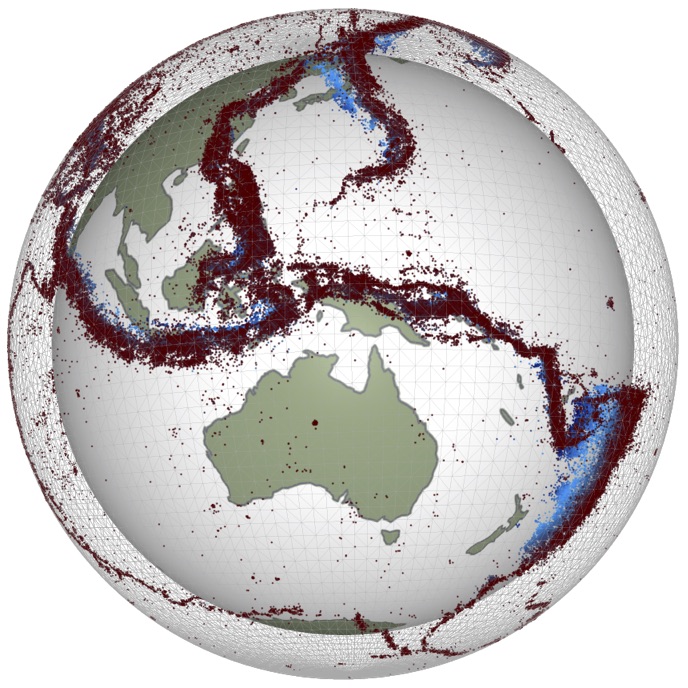Example 4 - stripy gradients on the sphere
Contents
Example 4 - stripy gradients on the sphere¶
SSRFPACK is a Fortran 77 software package that constructs a smooth interpolatory or approximating surface to data values associated with arbitrarily distributed points on the surface of a sphere. It employs automatically selected tension factors to preserve shape properties of the data and avoid overshoot and undershoot associated with steep gradients.
Notebook contents¶
The next example is Ex5-Smoothing
Define a computational mesh¶
Use the (usual) icosahedron with face points included.
import stripy as stripy
mesh = stripy.spherical_meshes.icosahedral_mesh(refinement_levels=4, include_face_points=True)
print(mesh.npoints)
Analytic function¶
Define a relatively smooth function that we can interpolate from the coarse mesh to the fine mesh and analyse
import numpy as np
def analytic(lons, lats, k1, k2):
return np.cos(k1*lons) * np.sin(k2*lats)
def analytic_ddlon(lons, lats, k1, k2):
return -k1 * np.sin(k1*lons) * np.sin(k2*lats) / np.cos(lats)
def analytic_ddlat(lons, lats, k1, k2):
return k2 * np.cos(k1*lons) * np.cos(k2*lats)
analytic_sol = analytic(mesh.lons, mesh.lats, 5.0, 2.0)
analytic_sol_ddlon = analytic_ddlon(mesh.lons, mesh.lats, 5.0, 2.0)
analytic_sol_ddlat = analytic_ddlat(mesh.lons, mesh.lats, 5.0, 2.0)
%matplotlib inline
import cartopy
import cartopy.crs as ccrs
import matplotlib.pyplot as plt
fig = plt.figure(figsize=(10, 10), facecolor="none")
ax = plt.subplot(111, projection=ccrs.Orthographic(central_longitude=0.0, central_latitude=0.0, globe=None))
ax.coastlines(color="lightgrey")
ax.set_global()
lons0 = np.degrees(mesh.lons)
lats0 = np.degrees(mesh.lats)
ax.scatter(lons0, lats0,
marker="o", s=10.0, transform=ccrs.PlateCarree(), c=analytic_sol, cmap=plt.cm.RdBu)
pass
Derivatives of solution compared to analytic values¶
The gradient_lonlat method of the sTriangulation takes a data array reprenting values on the mesh vertices and returns the lon and lat derivatives. There is an equivalent gradient_xyz method which returns the raw derivatives in Cartesian form. Although this is generally less useful, if you are computing the slope (for example) that can be computed in either coordinate system and may cross the pole, consider using the Cartesian form.
stripy_ddlon, stripy_ddlat = mesh.gradient_lonlat(analytic_sol)
import k3d
plot = k3d.plot(camera_auto_fit=False, grid_visible=False,
menu_visibility=True, axes_helper=False )
indices = mesh.simplices.astype(np.uint32)
points = np.column_stack(mesh.points.T).astype(np.float32)
mesh_viewer = k3d.mesh(points, indices, wireframe=False, attribute=analytic_sol,
color_map=k3d.colormaps.basic_color_maps.CoolWarm,
name="original",
flat_shading=False, opacity=1.0 )
plot += mesh_viewer
plot += k3d.points(points, point_size=0.01,color=0x779977)
plot.display()
## ## ##
from ipywidgets import interact, interactive
import ipywidgets as widgets
choices = { "analytic": analytic_sol,
"stripy ddlon": stripy_ddlon,
"stripy ddlat": stripy_ddlat,
"error ddlon": stripy_ddlon-analytic_sol_ddlon,
"error ddlat": stripy_ddlat-analytic_sol_ddlat }
@interact(choice=choices.keys())
def chooser(choice):
mesh_viewer.attribute = choices[choice].astype(np.float32)
range = np.sqrt((choices[choice]**2).mean()) * 0.5
mesh_viewer.color_range = [-range, range]
return
The next example is Ex5-Smoothing
